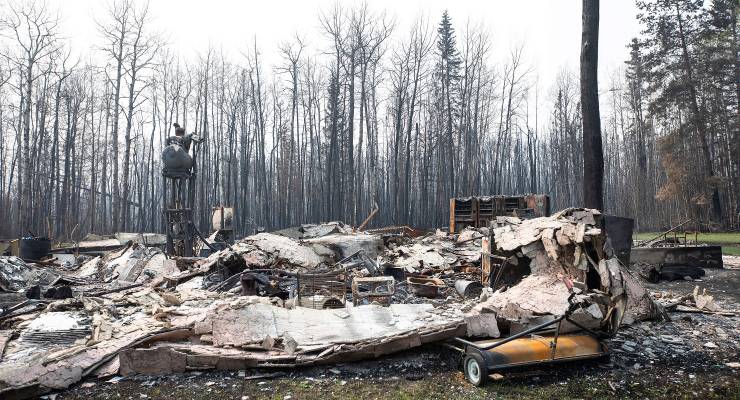
It’s not yet the first day of summer in Canada and the Great White North is battling hundreds of bushfires of an “unprecedented” scale, with blazes having charred some 2.7 million hectares so far — half of the total area burnt in Australia’s deadly Black Summer in 2019-20.
The size of Canada’s scorched land is 10 times the national 10-year average, a grave Canadian Minister of Emergency Preparedness Bill Blair said, declaring “these conditions early in the season are unprecedented” and exacerbated by climate change.
Firefighters from Australia and New Zealand are battling the ferocious blazes alongside Canadian authorities and will be joined by more than 300 firefighters pouring in from the US and South Africa.
Nova Scotia in the country’s east is grappling with its largest bushfire on record, spanning 17,000 hectares with flames as tall as 90 metres, according to the Department of Natural Resources. Two hundred homes and businesses have been destroyed, many filled with a lifetime’s worth of belongings.
More than 5000 men, women and children have been evacuated in small-town Shelburne County in addition to another 16,400 people in the nearby city of Halifax as the mercury climbs to 30 degrees today.
On the other side of the country in Alberta — the “Texas of the north” for its oil and gas industry — a state of emergency was declared last month. There are 58 active wildfires, with around a third burning out of control as of Friday morning, according to the Alberta Wildfire Status Dashboard.
Several First Nations communities, including Allison Bay and Dog Head, were evacuated as the largest bushfire reached 3000 hectares in size. As of yet, there have been no reports of fatalities anywhere in the country.
“When we see a period of warm, dry and windy weather in an area, it’s likely to mean if a fire starts it has a good chance of spreading,” Alberta Wildfire unit manager Christie Tucker said.
It could be a grim sign of things to come for Australia. The Bureau of Meteorology has forecast a warm, dry winter ahead for virtually all of Australia following the driest May on record, a combination of a probable El Niño (La Nina’s hotter, drier brother) and a positive Indian Ocean dipole.
BOM climatologist Zhi-Weng Chua told ABC it was eerily similar to the 2019 winter conditions that, followed by a dry spring, created the parched landscape of dry fuels causing what would go down in history as the Black Summer bushfires.
Vivien Thomson worked as a volunteer firefighter in Australia for 35 years. During the Black Summer crisis, she joined the Royal Fire Service (RFS) taking triple-000 calls throughout the nighttime, sending volunteer firefighters into many bushfire emergencies.
“We started in August 2019 and didn’t finish until March, some nine months,” she recalled. “You live and breathe it the whole time — even if you’re not fighting that fire, you’re watching it, you’re listening in about it and you’re providing support to other friends that may be involved in it.”
She told Crikey she remembers waking up to a fog of bushfire smog moving in every night in her rural community of Muttama as the south coast’s acrid plume blew in on the southerly change winds, some five hours away from her bedroom.
It’s a funny thing, she said — after decades of battling blazes, she can tell the severity of a bushfire based on the “plume of smoke, the way it’s moving, the colour it is”. She can tell if it’s the result of dense tinder-filled scrub or the corrosive building materials of homes or businesses.
Her partner, Robert Flint, has the same skill. He was a farmer by day and a volunteer firefighter by night during Black Summer, battling the dangerous Dunns Road megafire in NSW’s Snowy Valley — she remembers feeling so “cranky” at him when he’d relay his evenings in the morning light. It was life-or-death stuff.
Firefighters have this saying, Vivien said: “You’ve got to hurry up and wait” — in other words, bide your time and plan your approach to bushfires meticulously. It’s one of the hardest parts of wrangling multiple infernos that can move at up to 60km an hour, she said, particularly as volunteers witnessed fellow firefighters — often their friends — in peril.
After decades of fighting fires, it was Black Summer that led to her hanging up her uniform because of the mental toll. The triggers from that harrowing season, Australia’s worst in modern history, were far too great.
“I ended up resigning from work and coming home, going for long walks, spending time with my partner and kids. I couldn’t go through a long period of recovery again,” she said.
If our politicians and decision-makers saw the devastating and traumatic toll that bushfires take on the health of the people on the frontline, Vivien thinks the country and the world would be lightyears ahead on climate action.
“Do we want a future where our small communities and our rural areas are constantly being traumatised by disasters like floods and droughts, not just fires?” she asked. “At what point do politicians put community and families first and make the tough decisions?”
“I struggle sometimes to try to work out what the answers will be. Because how much worse can we get? I thought 2003’s bushfires were bad, I thought I’d never ever see that again in my lifetime as a firefighter. Then we had 2006, then we had 2009, and then we had 2019,” she said.
Vivien hopes she won’t need to add 2023 to that list.








“If our politicians and decision-makers saw the devastating and traumatic toll that bushfires take on the health of the people on the frontline, Vivien thinks the country and the world would be light years ahead on climate action.” And yet, Emma, that to be weighed against the political donations and offers of jobs after politics. It can’t be easy for the poor dears.
Spot on-and applies to this neoliberal bunch of sellouts in charge just as much as the other mob.
is this getting much cover in the MSM? – or are they busy ignoring it so that our politicians don’t have to deal with preparing Australia for the next catastrophe?
I went to Canada, over three decades back. One of the wettest and dampest places I’d seen. To have this scale of wildfire destruction seems almost impossible. They say politics is the art of negotiation, but lately I’m thinking that it’s the art of procrastination.
Canada’s a lot warmer now than it was 30 years ago, generally more than 1 deg C warmer.
As the world increasingly warms, the forests that evolved in cooler times must burn until they have thinned out. One thing that Australians can thank the aborigines for is thinned forests that have been repeatedly burnt into fire resistant ecologies. No such mercy is available for the dense conifer forests of Canada, Russia and Alaska. Across the decades ahead, we will come inured to news footage of relentless conflagrations, instead sharing images of beautiful sunsets, while puzzling over the increasing temperatures.
Actually most of that fire resistant forest has been removed because we banned them from burning and those fire resistant ecologies are now fire promoting ones.
Add to that the importation of feral, high fuel load weeds, and the recent unpredictability of weather patterns. However, Roger has a point. If enough research, resources, and trad knowledge were going into controlled burns – and enough litigation lawyers agreed not to milk profits if an accident occurs… Oh, who am I kidding? Litigation lawyers are gods, and hell awaits those who get in their way.
The difference being that Eucalyptus thrive on being burnt – not so the deciduous forests elsewhere.
We could have thanked Indigenous Australians for their fire management except they’ve been denied access to country for forests to have grown and thickened up: ref https://theconversation.com/how-1970s-conservation-laws-turned-this-paradise-on-earth-into-a-tinderbox-192401
Thank you, Emma. I have only heard(on radio news) snippets about the Canadian fires. Why on earth is our current government opening more coal and gas mines?? I cannot believe they are so brainless!
It is a travesty and lack of accountable government that what it is as they have a mandate to not open up any more gas and coal by the people. The Q&A audiences are turning away from the ABC due to the neo libs being in charge at our Aunty too; voting 66% for nuclear power is indicative of the narrow lack and right wing demographic growth being driven to drive debates and limited forums in the so called mainstream media; why are we selling our resources to off shore interests? It is Lazy, opportunistic and lacking in the belief we could value add and drive our ownership. We do not need skilled workers from overseas for example; we have the top university training and options here for our existent workers. But no the blokes at the top of the food chain want to own us and screw the planet and democracy and right to march against such dystopian horror
The politicians and billionaires driving climate change know that what they are doing is destroying the planet. They have at least the same information as the rest of us, maybe better information, and are at least as intelligent. The difference is they have done a cynical calculation and concluded that they will be dead when the worst of it kicks in so it wont bother them. They dont seem to be concerned that their children and descendants may face a difficult future. Similarly they dont give a rats about anyone else.